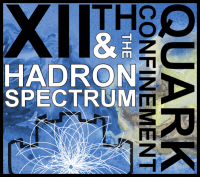Speaker
Description
Heavy quarks (charm and beauty) are interesting probes to study the Quark-Gluon Plasma (QGP) in high-energy heavy-ion collisions, since they are produced in initial hard partonic scattering processes on a short time scale and experience the whole evolution of the medium. They are expected to traverse the QCD medium, interacting with its constituents and losing energy through radiative and collisional processes. As a consequence of these interactions, the momentum distributions of open heavy-flavour hadrons are modified. A strong modification of the transverse-momentum distributions of heavy-flavour hadrons in Pb-Pb collisions with respect to binary-scaled pp collisions is observed, via the measurement of the nuclear modification factor RAA. The azimuthal distribution of heavy-flavour hadrons, in particular the elliptic flow ν2, reflects the initial spatial anisotropy of the overlap of the colliding nuclei. The elliptic flow brings information on the medium transport properties: on the question whether heavy quarks take part in the collective expansion of the medium at low pT, and on the path-length dependence of parton energy loss at high pT. Heavy-flavour measurements in pp collisions not only provide the necessary baseline to understand the results in Pb-Pb collisions. They are also an important test of perturbative QCD calculations. Moreover, heavy-flavour production in p-Pb collisions is affected by cold nuclear matter effects in the initial and final state, such as modification of parton densities in nuclei, kT broadening and gluon radiation. Heavy-flavour measurements in p-Pb collisions can help to disentangle the influence on particle production of those effects from that of the QGP formation.
In ALICE, open-charm production is studied through the reconstruction of the hadronic decays of D0, D+, D*+ and Ds+ mesons at mid-rapidity. The high precision tracking, good vertexing capabilities and excellent particle identification offered by ALICE allow for the measurement of particles containing heavy quarks (particularly D mesons) in a wide transverse-momentum range in pp, p-Pb and Pb-Pb collisions.
In this talk, a review of the main results on D-meson production in pp collisions at √𝑠 = 7 TeV, p-Pb collisions at √𝑠NN = 5.02 TeV and Pb-Pb collisions at √sNN = 2.76 TeV will be presented.




